|
Nature Comes Alive in Glass
by Bob Brooke
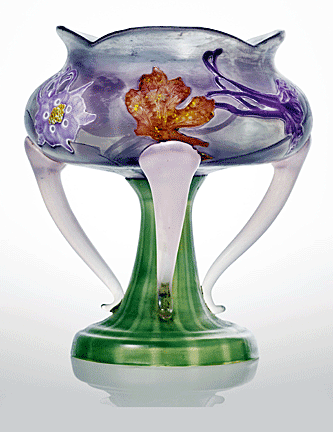 During
the last two decades of the 19th century, French glassmakers became more
perceptive and creative, expanding their artistic expression through
nature. The result was some of the most beautiful art glass ever made. During
the last two decades of the 19th century, French glassmakers became more
perceptive and creative, expanding their artistic expression through
nature. The result was some of the most beautiful art glass ever made.
Five glass artists stood at the top of the Art Nouveau Movement----Emile
Gallé, Auguste and Antonin Daum, Louis Comfort Tiffany, and René Lalique.
Emile Gallé
Nature heavily influenced Emile Gallé's glasswork, even his earliest
pieces, whick incorporated enameled floral motifs painted upon clear
glass. He was an avid botanist his entire life, collecting plants,
flowers, and insects to study and draw inspiration.
 Gallé
traveled throughout Europe studying works at museums and private
institutions, gaining insight from ancient glass antiquities to
Japonesque masterpieces, and everything in between. But it was Gallé’s
trip to the British Museum in 1871 that altered the course of his
career. Enamored by the famed ancient Roman cameo glass artifact known
as the Portland Vase, the artist began experimenting with cameo glass
upon his return to Nancy. Gallé
traveled throughout Europe studying works at museums and private
institutions, gaining insight from ancient glass antiquities to
Japonesque masterpieces, and everything in between. But it was Gallé’s
trip to the British Museum in 1871 that altered the course of his
career. Enamored by the famed ancient Roman cameo glass artifact known
as the Portland Vase, the artist began experimenting with cameo glass
upon his return to Nancy.
Color was a dominant force in all his designs. Galle’s method of
layering various colors of glass and exposing the base layers via
precise acid etching gave birth to some of the French glass master’s
most memorable creations. Layering metallic foils between the colored
glass prompted the discovery of exceptional highlighting effects that
breathed life into Gallé’s naturalistic motifs, and the incorporation of
air bubbles into the molten glass added a textural element never before
seen in the medium. He even continued in his experimentations with
enamel, mixing it with metal oxides to create absolutely breathtaking,
glistening effects that were revealed only in the final firing.
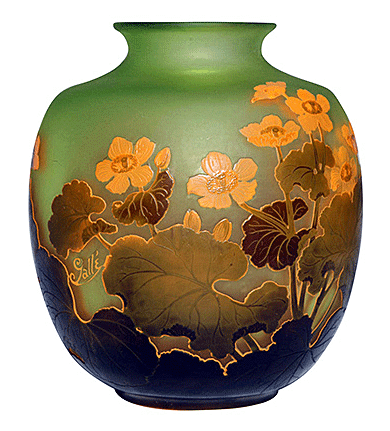 Gallé
had the ability to create the most picturesque landscapes and give life
to any flora or fauna within his glass art. His showing at the 1878
Exhibition Universelle and a decade later at the 1889 Exhibition
catapulted Gallé to international fame. His organic, flowing patterns
captivated a global audience and gave relevance to the growing Art
Nouveau Movement. Gallé
had the ability to create the most picturesque landscapes and give life
to any flora or fauna within his glass art. His showing at the 1878
Exhibition Universelle and a decade later at the 1889 Exhibition
catapulted Gallé to international fame. His organic, flowing patterns
captivated a global audience and gave relevance to the growing Art
Nouveau Movement.
Gallé was the most outstanding artist and technician among the French
glassmakers of the late 19th century. He based his early pieces on
historical themes, with enameling and gilding on transparent green,
white or amber glass. Around 1884, these gave way to realistically drawn
flowers and insects, still on transparent glass. During the following
years, Galle created some of his most original work in opaque colored
glass in a wide variety of techniques. He signed all the pieces. During
the 1890s, Galle changed his views about mass production and cut his
designs using acid, instead of on the wheel, into the superimposed
different colored layers of glass, a technique called “cameo glass.”
Auguste and Antonin Daum
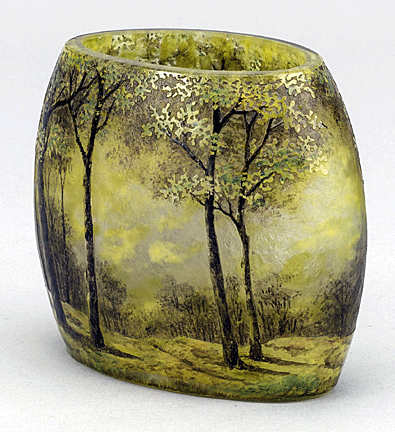 Nancy
was also the home of the renowned Daum family glassworks. Lawyer Jean
Daum founded the company in 1878. He had no glassmaking experience but
acquired the floundering Sainte-Catherine glassworks as payment for his
legal services. Nancy
was also the home of the renowned Daum family glassworks. Lawyer Jean
Daum founded the company in 1878. He had no glassmaking experience but
acquired the floundering Sainte-Catherine glassworks as payment for his
legal services.
During this time, the glassworks produced mainly watch crystals and
glass tableware. But Daum’s lack of both business and technical
experience severely affected the business, that is until his eldest son
Auguste joined the company in 1879. With no experience in glassmaking or
the industry, Auguste sought to learn everything he could about running
the glassworks effectively, thus saving the business.
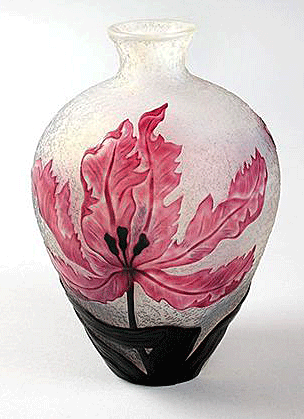 It
would be his brother Antonin, who joined the family business in 1887,
that would bring the artistic influence the Daum firm needed to truly
excel. A student of the leading Lunéville and École Centrale schools of
design and engineering, the youngest Daum actively sought to incorporate
Art Nouveau creativity into the firm’s glass. It
would be his brother Antonin, who joined the family business in 1887,
that would bring the artistic influence the Daum firm needed to truly
excel. A student of the leading Lunéville and École Centrale schools of
design and engineering, the youngest Daum actively sought to incorporate
Art Nouveau creativity into the firm’s glass.
Daum’s participation in the 1889 Paris Exhibition Universelle, where
they showcased their table glass amongst the masterpieces of Gallé and
other leading art glass creators was a tremendous inspiration to Antonin,
who immediately began working on his own designs. Free-blown, voluminous
vases, lamps and other vessels enveloped in rich cameos of florals,
animals, and even the themes of celebrated operas of the day were the
focus of Daum’s production. The utilization of hydrofluoric acid and
glass layering techniques allowed the firm’s artisans to create a wide
range of visual effects. With Auguste at the helm of the business and
Antonin directing the creative side, Daum soon proved to be a dominant
force during the Art Nouveau.
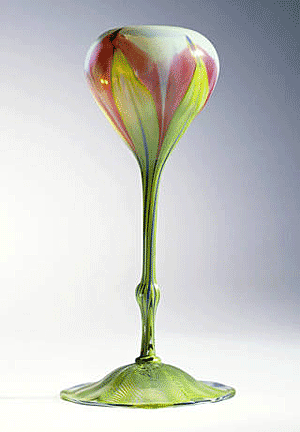 The
1893 Chicago World’s Fair was the stage upon which the Daum brothers
would showcase their cameo creations with exceptional success. The
firm’s acclaim grew throughout their showings at subsequent
international exhibitions, with the Paris Exhibition Universelle of 1900
being their most triumphant. The
1893 Chicago World’s Fair was the stage upon which the Daum brothers
would showcase their cameo creations with exceptional success. The
firm’s acclaim grew throughout their showings at subsequent
international exhibitions, with the Paris Exhibition Universelle of 1900
being their most triumphant.
Some of the most gifted glass artisans worked for Daum, including Victor
Marchand, Jacques Grüber and Eugéne Gall, who would remain with the Daum
company for over 40 years. With the influx of such superb talent,
Antonin established an in-house design school to train glass craftsmen
and to research new techniques, such as the use of gilt between layers
of glass, powdered glass to achieve textural effects and the inventive
use of enamels to provide dimension and additional color.
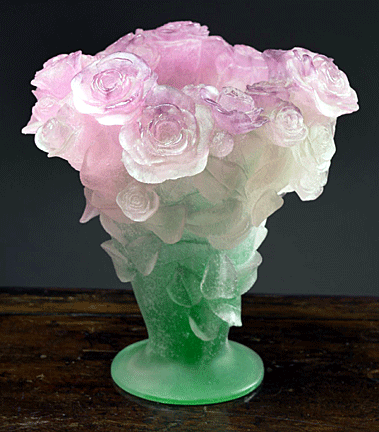 One
of Daum’s most impressive techniques was the use of pâte de verre, or
“glass paste.” The method is essentially a “lost wax” casting process
that uses powdered glass blended with a binding agent to create the
paste that was then placed in a mold and fired, ultimately achieving
dynamic shapes that can vary in thickness and display intense color. One
of Daum’s most impressive techniques was the use of pâte de verre, or
“glass paste.” The method is essentially a “lost wax” casting process
that uses powdered glass blended with a binding agent to create the
paste that was then placed in a mold and fired, ultimately achieving
dynamic shapes that can vary in thickness and display intense color.
When Gallé founded the École de Nancy in 1901, the Daum brothers joined
the fold and greatly contributed to the advancement of the Art Nouveau
style. Upon Gallé’s death just three years later, Daum effectively
continued in the founder’s footsteps and became the driving force behind
the movement.
The Nancy firm of August and Jean Daum (1853–1909 and 1825–85) has been
rather over-shadowed by Galle's reputation. Besides vases and
table-services painted with landscapes or vignettes en camaieu in the
18th-century style, the firm adopted in 1893 the technique of acid-cut
cameo glass, decorated with sprays of flowers, fruit, wild grasses or
landscapes. Although some pieces do closely resemble the work of Galle,
the range of colors is different; as they used a large amount of orange
and yellow.
Louis Comfort Tiffany
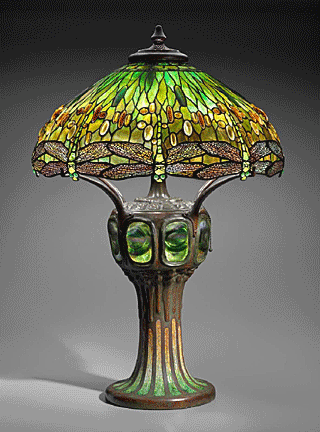 One
of the most well known names in Art Nouveau the decorative arts is Louis
Comfort Tiffany. His glass stands hands out glassmakers of the time. One
of the most well known names in Art Nouveau the decorative arts is Louis
Comfort Tiffany. His glass stands hands out glassmakers of the time.
Founded in 1878 by Louis Comfort Tiffany, son of Tiffany & Company
founder and jeweler Charles Lewis Tiffany, Tiffany Studios stood at the
forefront of American Art Nouveau. Though he worked in nearly every
decorative medium imaginable, it was his glass creations that made his
famous.
Well trained in painting and design, Tiffany traveled extensively
throughout Europe and Northern Africa gaining inspiration from the
bounteous decorative styles he encountered along the way. By 1878,
Tiffany & Company had gained great acclaim at the International
Exhibitions for its innovative silver, with Louis often accompanying his
father and exhibiting his own paintings. Here the younger Tiffany
encountered the works of European glass masters. He would then learn to
master the Art Nouveau design that captured this aesthetic movement.
Tiffany first began his experiments in glass in 1875. Focusing upon
stained glass, the gifted artist found methods by which to give his
glass a unique appearance, imitating folds, texture and overall
consistency to craft his famed and majestic Art Nouveau stained glass
windows that soon became known as "paintings in glas." Tiffany quickly
became the leading art glass creator in the United States. His clients
included Mark Twain, Cornelius Vanderbilt, and even the White House.
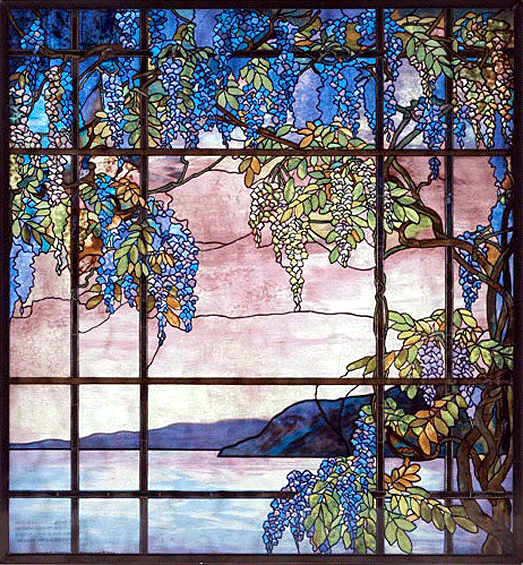
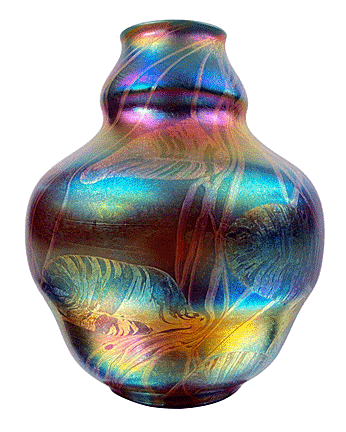 Tiffany
experimented constantly. Perhaps his most iconic discovery occurred in
1881 when he created his first pieces of “favrile” glass. Inspired by
the delicate iridescence found in specimens of ancient Roman glass,
Tiffany set out to replicate the look with outstanding results. Termed
“favrile” or “handcrafted”, his technique produced freely shaped forms
distinguished by an almost glowing iridescence that possessed an uncanny
dichroic trait that separated his creations from those of any other
glass artist in the world. From remarkable floriform vases to his most
recognizable lamps, his favrile glass art allowed people to enjoy the
beauty of nature year round. Tiffany
experimented constantly. Perhaps his most iconic discovery occurred in
1881 when he created his first pieces of “favrile” glass. Inspired by
the delicate iridescence found in specimens of ancient Roman glass,
Tiffany set out to replicate the look with outstanding results. Termed
“favrile” or “handcrafted”, his technique produced freely shaped forms
distinguished by an almost glowing iridescence that possessed an uncanny
dichroic trait that separated his creations from those of any other
glass artist in the world. From remarkable floriform vases to his most
recognizable lamps, his favrile glass art allowed people to enjoy the
beauty of nature year round.
René Lalique
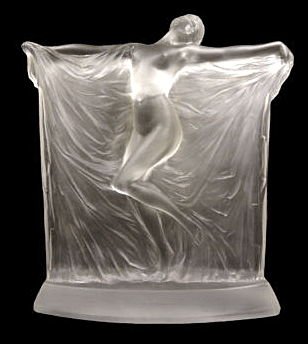 René
Lalique learned the arts of jewelry making, designing and sculpting, all
skills of which would influence his future glass masterpieces. But he
longed for a greater artistic challenge, and by 1900, he expanded his
horizons into the realm of glass. In just 10 short years, Lalique
transformed into a master glassmaker, creating everything from vases and
car hood ornaments, to chandeliers and perfume bottles. His motifs are
said to have focused on “females, flora and fauna”, highlighting
asymmetrical, undulating lines and sensuous curves encountered in the
natural world. René
Lalique learned the arts of jewelry making, designing and sculpting, all
skills of which would influence his future glass masterpieces. But he
longed for a greater artistic challenge, and by 1900, he expanded his
horizons into the realm of glass. In just 10 short years, Lalique
transformed into a master glassmaker, creating everything from vases and
car hood ornaments, to chandeliers and perfume bottles. His motifs are
said to have focused on “females, flora and fauna”, highlighting
asymmetrical, undulating lines and sensuous curves encountered in the
natural world.
Lalique incorporated glass in his exquisite gold and enameled jewelry
Galle naturally had many imitators and Delatte, Arsall, Le Verre
Francais, D. Christian & Sohn, Muller Freres and Michel are only a few.
Auguste Legras, working in the Paris suburb of St. Denis, also came
under his influence, but his work can be distinguished by its pastel
shades, often on an attractive creamy base. The glass of the
Cristallerie de Pantin has rather flatly drawn flowers enameled and gilt
on a frosted ground, or cameo landscapes, and is variously signed `De
Vez', `Pantin'or` Mont Joye'.
<
Back to More Antique Spotlights
Next Article >
|
